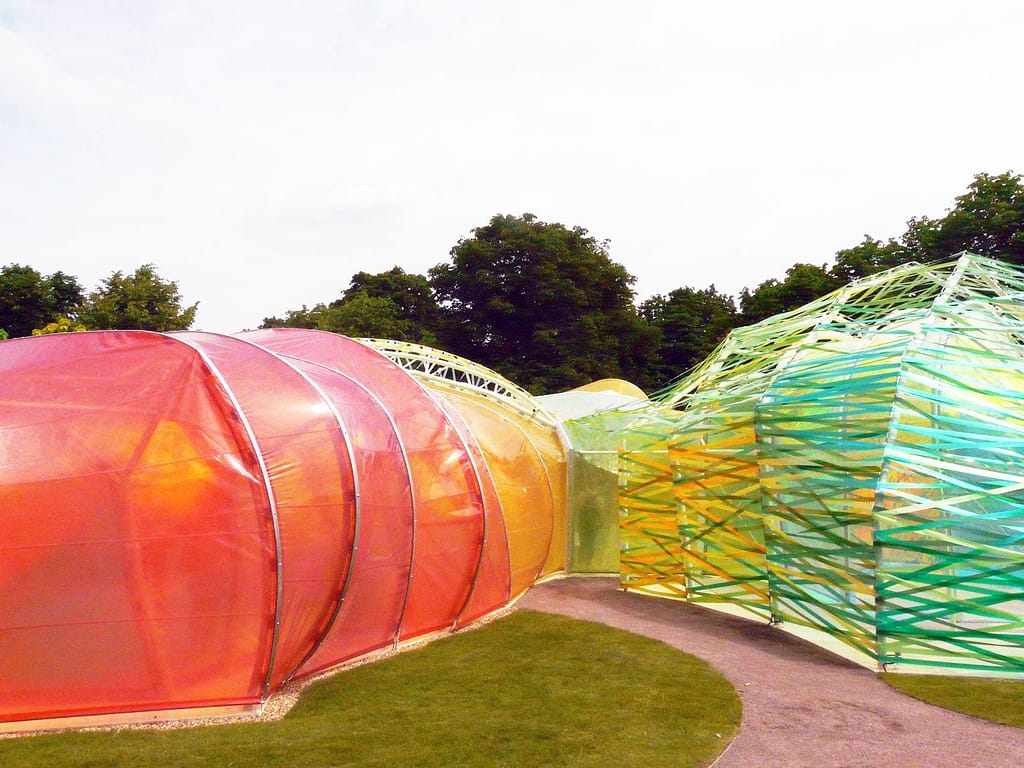For designers and architects, new materials and processes inspire innovation. From glass production and steel-reinforced concrete to 3D printing, new technologies are affecting modes of construction and the repertoire of available materials. Two of the greatest challenges to humanity are the growing scarcity of raw materials and the generation and disposal of waste. With socially conscious consumers now better informed about the environmental damage caused by the production of everyday goods, there is growing momentum towards ethical-based choices; a demand for sustainable materials and processes is being felt from fashion to packaging to textiles, footwear, and architecture.
The Fashion Industry
Some industries, like fashion, have major sustainability problems to address. During production, the fashion industry uses chemicals harmful to workers, consumes large quantities of energy and water, and is one of the biggest polluters in the world—the number two (oil is number one) cause of environmental pollution and waste. However, several clothing brands from Patagonia to Stella McCartney are making progress in minimizing their impact through alternative materials and processes, with footwear making the most progress.
The summer’s iconic sneaker is the Campo, one of a range of vegan shoes from ethical brand Veja. Made from a revolutionary material called C.W.L., Veja uses a waxed canvas that is 50 percent food industry corn waste. Adidas also has tackled the problem through The Loop, its first 100 percent recyclable shoe, which can be completely remade into another high-performance trainer. This follows the adidas x Parley training wear made of a minimum 75 percent upcycled marine plastic trash. Nike and Reebok are following suit with their own range of sustainable footwear, all looking at how to deal with plastic waste, the number one enemy in the eyes of most consumers.

Adidas is one of several brands looking to biodegradable and recyclable materials to reduce the fashion industry's impact on the environment.
Biodegradable Packaging
Some manufacturers are looking directly at providing alternatives to the sources of the plastic problem, especially in terms of packaging. Bioplastic is the most viable commercially, a strong transparent material made from corn starch, algae, seaweed, and even beetle shells that biodegrade over time. Others are looking at biomimicry to replicate the processes of nature in producing packaging that is compostable or biodegradable.
Companies like PaperFoam specialize in innovative green packaging, using bio-based solutions with extremely low carbon footprints designed to biodegrade. Others, such as Eco-products, create foodservice packaging made with renewable resources and recycled content. Their cups, mugs, paper food containers, utensils, stir sticks, and renewable straws, liners, and bags all designed to be compostable, cut down on waste as well as the energy used in their disposal.
Acoustics
Acoustic specialist Baux produces panels from Acoustic Pulp. Made from sustainably harvested Swedish fir and pine trees, the panels use recycled water and non-GMO wheat bran, potato starch, citrus fruit peels, and plant-derived wax as materials, and zero chemicals are used in its manufacture. Commercial textile and flooring manufacturers, such as Kvadrat and Interface, are looking to develop net-zero products that not only have recycled content from their own lines but reuse offcuts of materials from their processes.

Swedish fir and pine trees are being used to create a sustainable acoustic pulp.
Construction Industry
Scaling up from ethical personal consumption and manufacturers, one of the biggest generators of waste is the construction industry. More than 548 million tons of debris is generated annually in the United States. To put that into perspective, this is more than twice the amount generated by municipal solid waste. And it’s a problem that will only grow over time. Transparency Market Research estimates that the number will reach 2.2 billion tons globally by the year 2025. Waste includes materials from excavation, roadwork, and demolition as well as complex waste like plastics, metal, ceramic and cardboard. Building materials including wood, shingles, asphalt, concrete and gypsum make up more than half of the construction waste generated annually.
The response among many developers and construction companies is to adopt reuse and recycling policies for materials, fixtures, furniture, and fittings as part of a circular economy where waste can be drastically reduced. Several manufacturers and researchers are looking at how the design of their materials can contribute to positive solutions by biodegrading naturally.
Reimagining Building Materials
With concrete, one of the most used materials, students at Imperial College London have developed Finite, a composite material that mimics its properties using desert sand (which is more abundant) rather than fine white sand. Unlike concrete that can’t biodegrade, Finite’s organic binders allow it to be left to decompose although it can also be collected and reused for multiple life-cycles, reducing material consumption.
Even the humble brick is being reimagined. Sporosarcina pasteurii, a bacterium with binding qualities sometimes used to solidify soil that holds road signs in place, has been combined with sand-filled moulds to create a material 70 percent the structural strength of concrete. With added nutrients from urea, calcium, and fertilizer, it uses one-sixth of the energy required for brick making in its production and is completely biodegradable. Used in partnership with communities in the developing world, it has already provided housing solutions as it requires little or no construction experience to deploy.
Insulation
UK-Based firm Biohm looked at insulation and is using a mushroom-based product instead of traditional glass fibre, which can pose breathing problems if inhaled during construction and demolition. The advantage is that mushrooms are naturally self-extinguishing, purify air, and are biodegradable (not to mention vegan). The insulation blocks are made by allowing fungus within the material to feed off sawdust and grow into a mould. Once dried, the material growth halts and the result is a rigid material called mycelium, which can be sanded and painted. Biohm is currently developing commercial and residential projects across Europe using this technology.
Pop-ups Installations
The same approach to material technology has recently been used for pop-up installations by Italian architecture studio Carlo Ratti Associati (CRA). As part of Milan Design Week, CRA produced an outdoor installation by injecting mushroom spores into an organic base to create a series of arches. Part of its appeal was the use of natural processes to self-build. Fungi has a fast growth time; once the frame was in place the project came together in just over 6 weeks and could be shredded and composted at the end of the project period. With the ability to easily assemble, disassemble, and reconfigure structures, pop-ups are the perfect vehicle to demonstrate smart, agile solutions that can serve as a model for scaled growth.
Another successful installation using non-chemical additives and natural processes was the Ball-Nogues Studio Pulp Pavilion at the annual Coachella music festival. Here, orange-pigmented paper pulp was air blasted across a latticework structure of twine, creating a scalloped roof structure that provided shade and an enclosed space. The arid climate of the desert region helped speed up the drying process and preserve the pavilion once constructed, and the materials could be recycled or composted.
More durable materials for longer-term installations are also being developed. Bioplastics show some of the greatest potential for use, breaking down much faster than synthetic plastic and producing compostable biomass as waste. In 2015, Spanish firm Selgascano designed the Serpentine Gallery Pavilion and annual summer installation in Hyde Park, incorporating a double-layered plastic skin made from ETFE—a kind of fluorine-based plastic in a variety of colours—wrapped around a series of metal arches. This material has a high resistance to corrosion and remains very strong in different temperature ranges, making it ideal for outdoor use. Following its installation, it has since been disassembled and reassembled multiple times across the globe.

The 2015 Serpentine Gallery Pavilion contribution from Spanish firm Selgascano, made largely from a flourine-based plastic. Image via Loz Pycock.
The global production of bio-based chemicals now exceeds 60 million tonnes and is expected to increase to at least $12.2 billion by 2021. All of which is great news for architects and designers. The opportunities presented by materials that can self regulate and self-build when intelligently designed means that we can limit the energy used in construction, cut down on labour, and eliminate waste.
All of which creates opportunities for adventurous structures, and some are quite literally out of this world, focused on supporting colonies on Mars. Spanish architect Alberto Villanueva of IDEA Architecture Office is looking at the possibilities of using mycelium mixed with Martian soil and water drawn from ice below the planet’s surface. The mixture’s organic growth coupled with the 3D printing of ferrous elements in the soil would allow for the creation of enclosed spaces that could withstand the extreme climate on the Martian surface. Furthermore, as an added benefit of the organic growth, its chemical composition would allow for the conversion of carbon dioxide in the atmosphere to oxygen. Deployed in advance of terrestrial colonies, these structures offer the possibility of a pre-constructed infrastructure that could support human life, with the construction process continued on arrival. The structures would be designed to decompose over 5 years, eliminating any negative material footprint and the expense associated with transporting heavy building materials across space.
The increasing number of options and materials for sustainability by no means imply that we are out of the woods, but the possibility of a light at the end of the trail is ours to collectively pursue and ensure. And designers and architects have always been quick to explore and pioneer innovative solutions.
More great IA Thought Leadership - Biodegradable Materials: Design and Architecture via @IAarchitects

